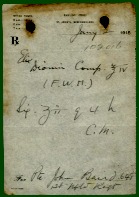

The Newfoundland Contingent
In October 1914 the First
Contingent of the Newfoundland Regiment arrived
in England without caps and rifles. Because khaki
cloth had not been available to equip them in
standard British uniform, instead wearing blue,
they became known as the "Blue
Puttees".
The authorized march of the Royal Newfoundland
Regiment is The Banks of Newfoundland.
 Dr. Cluney McPherson, a
well known Newfoundlander invented the gas mask
in WW1. Dr. Cluney McPherson, a
well known Newfoundlander invented the gas mask
in WW1.
The Royal Newfoundland Regiment is comprised of
the following subunits: 1st Battalion HQ, A
Company, (St. John's); 2nd Battalion HQ, B
Company, (Grand Falls); A Company, (Corner
Brook); and C Company (Stephenville).
Newfoundland suffered its greatest loss at
Beaumont Hamel on July 1st 1916. Of the 801men
who went into battle only 68 could answer the
roll call when it was taken the next day. The
final count: 255 killed or dead of wounds, 386
wounded, and 91 missing.
The Newfoundland Regiment was granted the title
"Royal" in November of 1916 by His
Majesty King George V. The distinction was one
that no other regiment of the British Army was to
have conferred on it during the First World War
while fighting was still in progress.
Private Thomas Ricketts, a member of the Lewis
Gun detachment, who was only 17 at the time,
became the youngest winner of the Victoria Cross
in the British Army.
Britain's "oldest colony" sent 8,500
soldiers and sailors abroad in the First World
War, out of a population of less than 250,000,
over 1,500 gave their lives in the end.
The Memorial University College (St. John's) was
opened in 1925 and named in memory of the
colony's servicemen who had lost their lives.
Newfoundland has established five memorials
overseas to commemorate the bravery shown by her
men during the First World War. They are:
Beaumont Hamel, Gueudecourt,  Monchy,
Masnières, and Courtrai memorials. The Courtrai
Memorial is located in Belgium while all others
are located in France. These all consist of
bronze caribou statues and were the work of Basil
Gotto, who also sculpted the statue of the
"The Fighting Newfoundlander", a
tribute to the men of the Regiment which was
established in Bowring Park. Monchy,
Masnières, and Courtrai memorials. The Courtrai
Memorial is located in Belgium while all others
are located in France. These all consist of
bronze caribou statues and were the work of Basil
Gotto, who also sculpted the statue of the
"The Fighting Newfoundlander", a
tribute to the men of the Regiment which was
established in Bowring Park.
Newfoundland also has its own
national memorial which is located near St.
John's Main Street with the famous old harbour as
its backdrop. It commemorates all of
Newfoundland's wartime achievements on land and
sea. The Royal Newfoundland Regiment, the Royal
Naval Reserve, the Mercantile Marine and the
Forestry Corps are each represented by lifelike
bronze figures. Above, on a granite pedestal, a
female figure representing freedom holds aloft a
torch.
On July 1st of each year - the anniversary of the
Battle of Beaumont Hamel, we honor these brave
Newfoundland men, we remember the great sacrifice
they made and the loved ones they left behind.
The Royal Newfoundland Regiment still exists to
this day. You may contact them at:
Regimental Headquarters:
Box 2028
St John's, Newfoundland
Canada A1C 6B5
| Escape From
Germany | Battle
Honors |
| Trail of
the Caribou Postage Stamps | Poetry
Series | Links |

View My Guestbook
Sign My Guestbook

Page created by Martha Collier
|